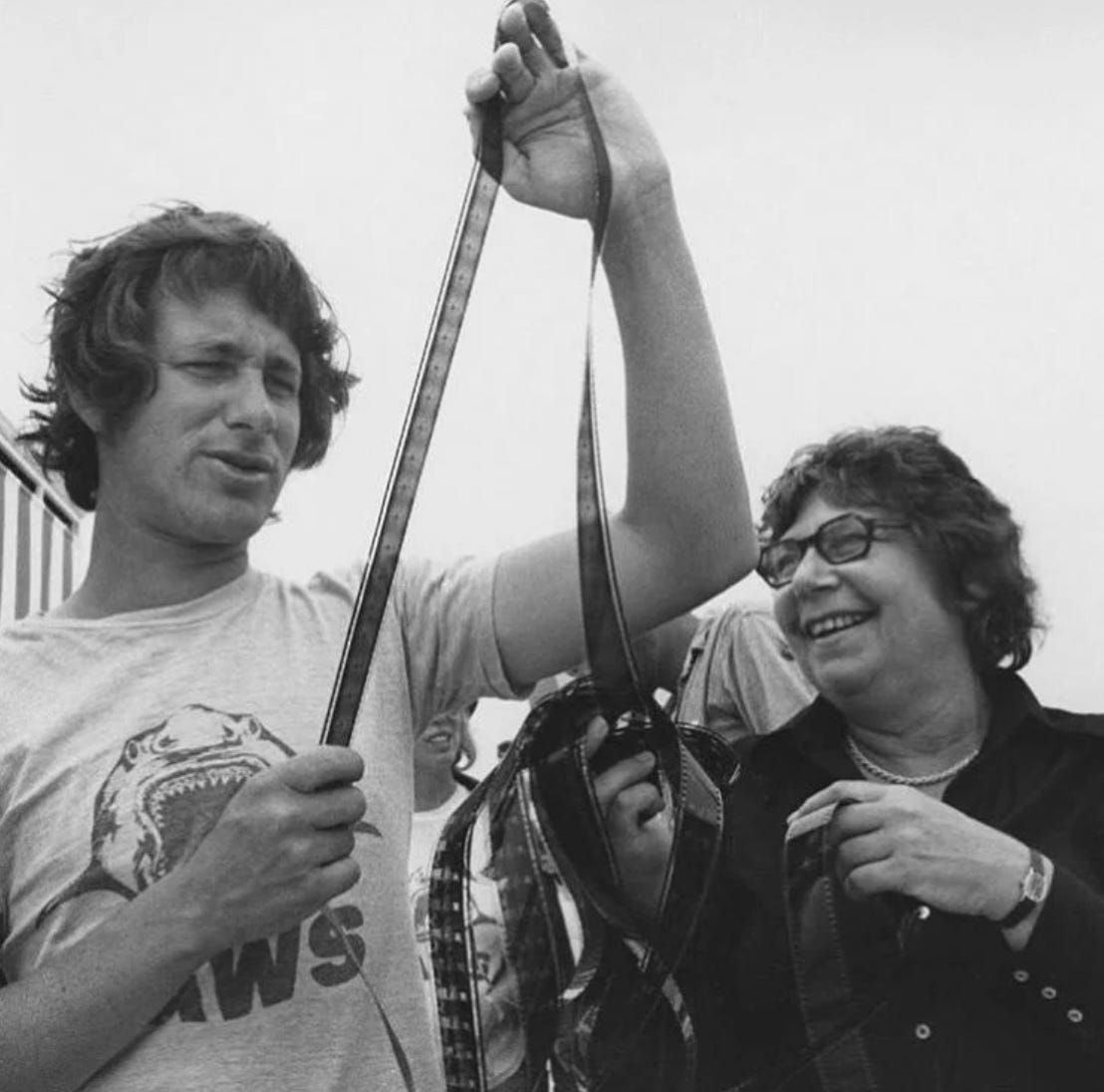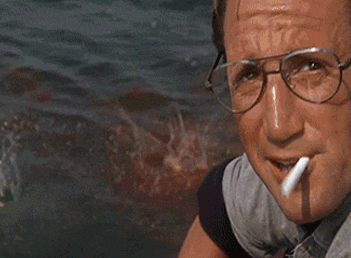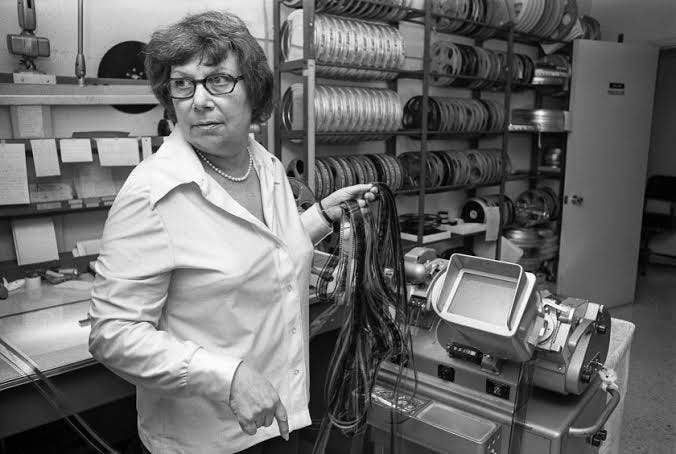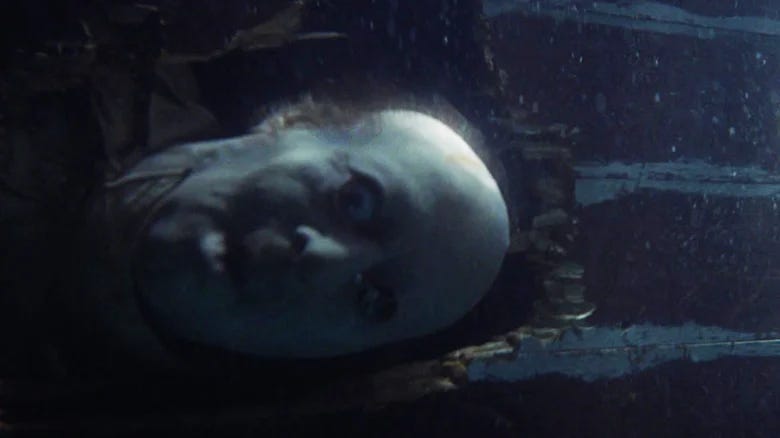The Hidden Hand: Verna Fields, The Editor Who Saved Jaws from Drowning
How editor Verna Fields turned a broken shark movie into the world's first summer blockbuster.
Hi everyone,
Before the blood in the water, there was blood on the set.
Jaws didn’t just invent the summer blockbuster, it nearly drowned trying.
Sure, we all remember the dorsal fin, the shrieking violins, the beaches cleared in panic. But behind the scenes? The making of Jaws was less smooth sailing and more full-blown maritime disaster. Mechanical sharks sank. Schedules collapsed. Spielberg nearly lost his career — and maybe his sanity.
Yet somehow, out of that saltwater chaos came a masterpiece. And at the heart of it all wasn’t just a hungry great white or a 26-year-old Spielberg swinging for the fences.
It was an editor.
This is the story of Verna Fields — the “Mother Cutter” — and how one woman in a dark cutting room turned a sinking ship into cinematic legend.
Let’s dive in.
26 year-old Steven Spielberg and Verna Fields on set of Jaws (1975)
Even if you’ve never actually watched Jaws, you’ve still heard of it.
The two-note score that slithers into your subconscious. The dorsal fin slicing through water. The empty beaches. Screaming swimmers.
If you actually haven’t heard of it then close this tab, go watch the movie, and then come back.
Released in 1975, Jaws was one of the first films to open wide across hundreds of theaters. It practically invented the “Summer event movie” and turned Steven Spielberg from precocious 26-year-old director into a generational icon.
But what fewer people realize is just how close Jaws came to sinking.
Shot on unpredictable waters off Martha’s Vineyard, the production spiraled into a nightmare.
And the film’s centerpiece; the mechanical shark, “Bruce” refused to play ball (or whatever sharks do for fun).
Cue a shoot that stretched over 100 days behind schedule, a budget that nearly tripled, and studio execs wishing they’d stuck with law school.
Spielberg was convinced Jaws would be the first and last studio film he ever directed.
But someone had other ideas…
Chaos On the Coast
The making of Jaws was a disaster.
Steven Spielberg was young, talented, and fearless. He had just turned heads with Duel and The Sugarland Express, and Jaws was his first major studio feature. He was determined to do it right.
That meant shooting not on a backlot or soundstage, but on the open water of Martha’s Vineyard.
A real ocean, real sunlight, real issues.
From the start, it was a production cursed by nature and naiveté. Spielberg insisted on wide, cinematic shots that captured the vastness of the sea. But shooting on the actual ocean meant nothing could be controlled.
Water was calm; then choppy. One frame had clear skies; then cloud cover. A sailboat drifting innocently two miles in the background could halt production for hours until it cleared frame.
By which time the light had changed, and the day’s shot was ruined.
One crew member later joked, it was the easiest paycheck he ever earned. They got paid full day rates to stand around, waiting for the Atlantic to behave.
And then came the shark.
Spielberg had spent two-thirds of the film’s effects budget on his mechanical star, three life-sized models of a great white nicknamed “Bruce.” But the moment they were water-tested, everything fell apart.
In the first trial, the shark sank to the ocean floor. Divers had to retrieve it. Even after adjustments, saltwater continued to destroy the machinery inside.
The one thing the film depended on, the shark, barely worked.
Weeks of production ticked by without a single usable shot of the creature and Spielberg started to panic.
Cutting Through Water
By the time the Jaws footage hit the cutting room, Spielberg had done everything he could to make the shark work.
The result was hours of footage showing a 25-foot rubber fish lurching awkwardly through the Atlantic.
Spielberg was desperate. He wanted audiences to feel the terror he had in his head. He wanted to use what little shark footage they had and force it in if he had to.
But when the footage landed on editor Verna Fields’s desk, she saw something different.
She saw what wasn’t working and what could.
Her move was deceptively simple.
Don’t show the shark.
Was Verna really about to tell Spielberg that his film about a shark, his film that had spent several millions of dollars literally on shark effects, should not show a shark….
Yes.
Instead, Fields reframed the film’s terror around the shark’s absence.
She cut from underwater point-of-view shots to frightened glances above the surface. Speed-ramped splashes, yellow barrels, and sharp reaction shots were used to suggest presence without actually showing it.
Most importantly, she leaned into John Williams’s sparse two-note theme duunnn-dunnn to give the illusion of a shark’s approach.
That sound became the stand-in for the monster and your brain filled in the rest.
And that rest truly is history.
Verna Fields the “Mother Cutter
By the time Jaws rolled into her cutting room, Fields was 56 years old and already a heavyweight in editing craft.
She had edited more than 30 films, documentaries, and TV episodes. She had supervised sound for major features, taught editing at USC, and mentored a young circle of filmmakers who would go on to define an era: Spielberg, Lucas, Scorsese.
They called her “Mother Cutter.”
A kind of cinematic surgeon, known for precision and narrative instinct. She could take raw, chaotic footage and find the emotional core, knowing exactly when to tighten, when to hold, and when to let a moment breathe.
Spielberg had already trusted her with his first theatrical film, The Sugarland Express, and credited her with grounding his work.
But Jaws was different.
He had handed her a broken thriller about a rubber shark and she turned it into a masterclass in suspense.
Mother Cutter’s Pool Party
One of the most iconic scares in Jaws, wasn’t shot on the open sea, or in a studio tank, or a soundstage.
It was shot in Verna Fields’s backyard.
Yes, the editor’s actual swimming pool in Los Angeles.
After test screenings flagged a sag in tension before the final act, Verna proposed a solution. She told Spielberg they needed one more jolt. Something unexpected. Something that would snap the audience back into fight-or-flight mode.
Spielberg agreed. But with the ocean set long wrapped, there was no time or budget for anything elaborate.
So they got scrappy.
Spielberg and a small crew showed up at Verna’s house with a camera, a rubber severed head, a piece of a fake boat, and some milk powder. They dumped the milk into the pool to cloud the water, dropped the prop head into a submerged hole in the set piece, and rolled camera.
In just a few frames, the scene was burned into horror history: Hooper diving underwater, peering into a wrecked boat, and Ben Gardner’s lifeless head bursts into view.
Sharp cut.
There’s something absurdly poetic about it. A pivotal scare in one of the most influential thrillers of all time was filmed not on some high-tech production stage, but in the calm, chlorinated waters of the editor’s home.
A Hollywood monster, born in suburbia.
And yet, it’s fitting. A tale in approaching editing like a craft, not a mystic art.
Get what you need. Use what works. Don’t overcomplicate it.
And no one understood that better than Mother Cutter.
“Fin.”
Jaws went on to gross nearly half a billion dollars worldwide. Completely unheard of in 1975. Suddenly, the idea of releasing a big, crowd-pleasing thriller in the middle of summer, once considered commercial suicide, became the norm.
Before Jaws, the notion of spending a sweltering July afternoon in a dark, movie theater was completely alien.
Summer now became a season of spectacle. And Spielberg at just 27 became untouchable.
But if Bruce the shark had worked and was reliably photogenic, Jaws might’ve been just another creature feature. Instead, it became something rarer: a suspense manifesto built on what we didn’t see.
When Jaws won Verna the Academy Award for Best Film Editing and the American Cinema Editors Eddie Award, she became one of the rare few editors to earn public recognition in a director-driven industry.
Universal then made her VP of Feature Production, becoming one of the first women to hold a senior executive role at a Hollywood studio.
Verna sadly passed away in 1982, but her DNA lingers in every jump scare, every underwater POV, or frame of suspense built not on showing.
It’s easy to give flowers to Spielberg, or to John Williams and his score. But spare a petal for Verna; the woman in the dark room, steadying the ship when it was sinking.
Like so many female editors in the timeline of cinema, she shaped the frame without ever standing in it.





